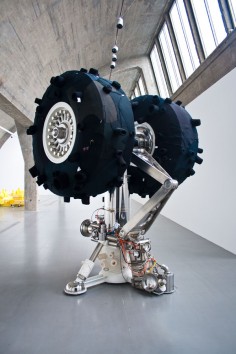Yin Xiuzhen
ИНЬ СЮЧЖЭН
尹秀珍
Nowhere to Land
source: eastbysoutheast
In evoking the human aspects of globalization, Nowhere to Land is especially timely in the dynamic Chinese context, and Yin’s work gives a compelling account of what the view from inside the seismic changes of the country might look like.
Yin (b. 1963), a true Beijing native, presumably bears the perfect vantage point from which to witness the massive Chinese economic transformation.
Since graduating from Capital Normal University in Beijing in 1989 with a B.A. in oil painting, the artist’s work has been featured internationally. Recent exhibitions include solo showings at the Groninger Museum in the Netherlands (2012) and New York’s MoMA (2010), as well as a smattering of group exhibitions in cities across the world, including Moscow, Shanghai, Venice, Sydney, Sao Paolo and San Francisco.
Yin’s work is all about the art of looking and deciphering. Incorporating homely, intimate and personal items into larger constructions, she emphasizes the superficial qualities of what seem at first impression to be straightforward sculptures. And in doing so, she problematizes the underlying assumptions behind glossy Chinese narratives of progress and globalization.
.
.
.
.
.
.
.
source: pacegallery
A leading female figure in Chinese contemporary art, Yin Xiuzhen (b. 1963, Beijing, China) began her career in the early 1990s following her graduation from Capital Normal University in Beijing where she received a B.A. in oil painting from the Fine Arts Department in1989. Her artworks have since been shown extensively in various international exhibitions. Best known for her works that incorporate second-hand objects, Yin uses her artwork to explore modern issues of globalization and homogenization. By utilizing recycled materials such as sculptural documents of memory, she seeks to personalize objects and allude to the lives of specific individuals, which are often neglected in the drive toward excessive urbanization, rapid modern development and the growing global economy. The artist explains, “In a rapidly changing China, ‘memory’ seems to vanish more quickly than everything else. That’s why preserving memory has become an alternative way of life.”
.
.
.
.
.
.
.
source: baikebaidu
曾获联合国教科文颁发的青年艺术家奖金;当代中国艺术奖。曾参加过1997《运动中的城市》(国际巡回展);1998《世纪–女性艺术展》(北京);1998《半边天:中国当代女性艺术家展》(德国);1998《在内之外:中国当代艺术展》[Insaid (out)](国际巡回展);1999《第三届亚太三年展》(澳洲);1999《超市.当代艺术展》(上海);2000《瞬间:二十世纪末的中国艺术》(芝加哥);2000《”主题.副题”亚洲女性艺术展》(新加坡);2001《生活在此时:中国当代艺术展》(柏林);2002《光州双年展》(韩国);2002《福冈三年展》(日本);2002《丰收:中国当代艺术展》(北京);2002《首届广州三年展》(广州); 2003《纬度怎样成为了形式》(美国)等几十个国内和国际展览,作品丰产,影响广泛。她的特点是将人的经历和记忆,时代的印痕,结合具体环境创作,并有强烈的视觉感染力。代表作品《衣箱》、《废都》、《洗河》、《树琴》、《酥油鞋》、《尹秀珍》、《京剧》、《旅行箱》、《欲望锦标》、《国际航班》、《超市》等。
她的作品多关注自己个人的经历和记忆与时代的关系。”谈到尹秀珍的作品,你可能会讲得零碎、不连贯,但却有着某种兴奋的节奏。她的作品是在最隐私、最缜密、最纤细与最公开、最粗糙、最粗暴的物料之间的固有冲突所产生及形成的。特别是那些与女性记忆欲望有关联的私人物件:衣服、鞋子、家具、照片,与被拆毁建筑的残余物、水泥瓦砾对峙。在折叠与开展、凝结与溶化的静默名声中,年轻女性的梦想世界与急剧变异社会之间的交战发生。其中有着一种精神分裂的特质。对活在每日发现物质改善的喜悦,又缅怀失去了安宁、感性、简朴生活的一代人来说,这种状态普遍存在。理想主义在今日已经不再可能。现实急速旋转到难以控制的地步。当”创作”这个字,在越来越没趣、疯狂地追逐物质主义”进步”的社会中被庸俗化、被低贬时,如何为创作的心灵争取一个空间呢?这正是”后理想主义”年代艺术家最关心的。有些人已选择愤世嫉俗,在自我揶揄的慰藉与市场成功的背后中隐藏自己。但其他的,如尹秀珍,继续争取似乎不可能的见证、批判空间,以及在近代中国史上,女性的感性心灵与社会革命的动乱之间斗争十分剧烈,她搜集那些的物件与影像,再循环到她的作品里。”
尹秀珍的作品基本分为两种类型:”一种是围绕着个人经历和生活的作品;另一种是结合具体的展示地点来唤起对某种公共性主题的注意。在高速发展的今天,尤其是在中国这一特殊的后社会主义的社会里,个人日常性正在转变成某种不可预测的无常性。尹秀珍作品中对日常的纪念性一方面反映出社会变化所造成的日常经验的迅速历史化;另一方面则反映出她对个人历史的强调,并在其中发现某种个人的意义与不可重复的独立经验。与强调个人性作品同时发展的是结合某些具体展示地点的作品,尹秀珍把公众参与作为作品的一个非常重要的方面,她通过对特定展示地点的历史与现状的研究,同时利用她对日常性的特殊洞察力和敏感性,把公众吸引到作品中,并参与作品的完成。在这个过程中,个人对日常性知觉和意识被提升到公众集体的对日常性的知觉和意识。公众在这一参与中,不仅完成了作品的目的,而且还把参与延伸到某种对日常的反思和行动里。在这一过程中,公众重新整理了自我的表现形式。
在这两类作品中,尹秀珍始终把某种”变化”和”历史”的感觉作为她作品的展示基点。这些”变化”和”历史”构成尹秀珍作品最大的特色。在无限制的变化和急速求新的当代社会里,尹秀珍充满历史和变化的作品显得格外的与众不同。作品中强烈的个人色彩把某种真实的具体性带入到当代生活领域里,人们可以从中感受到他们正在经历的过程以及这个过程所产生的深刻变化。”
.
.
.
.
.
.
.
source: cnblouinartinfo
尹秀珍的创作对于社会现实的反思开始于上世纪九十年代,从那时起她就将目光关注在中国经济蓬勃发展背景之下和全球化进程之中所暴露的问题上,并以此为主题创作了大量的装置作品。在她1995年的早期作品“洗河”中,她将成都市府南河中的污水冻结城冰块,放置在河岸附近,交由路人以清水进行洗涤,而最终冰融化为水也无法被清洁,又渗进河中。在这个包含行为和雕塑语言的创作中,她向人们提示着环境污染带来的危害性后果。开始于2001年的“可携带城市”系列装置则反映了个人与都市的关系,在国际旅行常用的旅行箱里尹秀珍用旧衣服和布料缝制出不同城市的建筑景观,香港、纽约、墨尔本等国际都市都被她巧妙的再现了,这些装在箱子里的城市看起来。
.
.
.
.
.
.
.
source: underamacomar
Yin nació en Beijing en 1963 y a finales de los ‘80 comenzó a exponer sus trabajos luego de recibirse en la carrera de Artes Plásticas de la Universidad Normal de su ciudad natal.
Es una de las artistas chinas más activas actualmente y con más proyección internacional. Expuso sus obras tanto en China (en el Museo de Arte Contemporáneo de Beijing y en el museo YuanGong de Arte Moderno de Shanghai, entre otros), como en el exterior (Alemania, Francia, Italia, Audtralia, Gran Bretaña, Japón, Corea del sur, Estados Unidos), incluso participó en el 2004 en la Bienal de San Pablo y en 2007 en la Bienal de Venecia. Además recibió varios premios, entre ellos se destacan el CCAA (Chinese Contemporary Art Awards) y el Premio a Artista Joven entregado por la UNESCO.
Sus obras consisten principalmente en performances, esculturas e instalaciones en las cuales el espectador puede participar e interactuar con lo que lo rodea. Para Yin Xiuzhen su arte es el medio por el cual reflexiona acerca de temas actuales y propios de nuestra época como son la globalización, el ritmo acelerado de crecimiento de las grandes ciudades y el vínculo del individuo con su entorno. Los materiales predilectos de la artista son los objetos en desuso, viejos, abandonados, los escombros o restos de algún edificio demolido. Aquello que pareciera que no sirve más y se abandona pero que en realidad lleva consigo una memoria, una información imposible de borrar que nos dice mucho acerca de quien lo utilizó y del momento al que perteneció. Especialmente la ropa usada, vieja, descartada, es el material que más se repite en sus obras.
.
.
.
.
.
.
.
source: wdwnl
Yin Xiuzhen (geboren in Beijing, 1963) en Song Dong (geboren in Beijing, 1966), zijn beiden actief als onafhankelijk kunstenaar, maar verkennen tezamen het idee van samenwerking door hun eigen samenwerkingen te baseren op het bekendste paar van China, de eetstokjes. Beiden hadden recentelijk solotentoonstellingen in het Museum of Modern Art in New York. Yin Xiuzhens werk werd getoond tijdens de 52ste Biënnale van Venetië, het Schirin Kunsthalle Frankfurt en de Gwangju Biënnale. Het werk van Song Dong was te zien tijdens Documenta 13, de 54ste Biënnale van Venetië, bij de Asia Society in New York, de Fundació Joan Miró, de 8ste Biënnale van Instanboel en de 26ste Biënnale van Sao Paolo. Song won ook reeds verscheidene prijzen voor zijn werk zoals tijdens de Gwanju Biennale in 2010 en als UNESCO/ASCHBERG Bursary Laureate.


